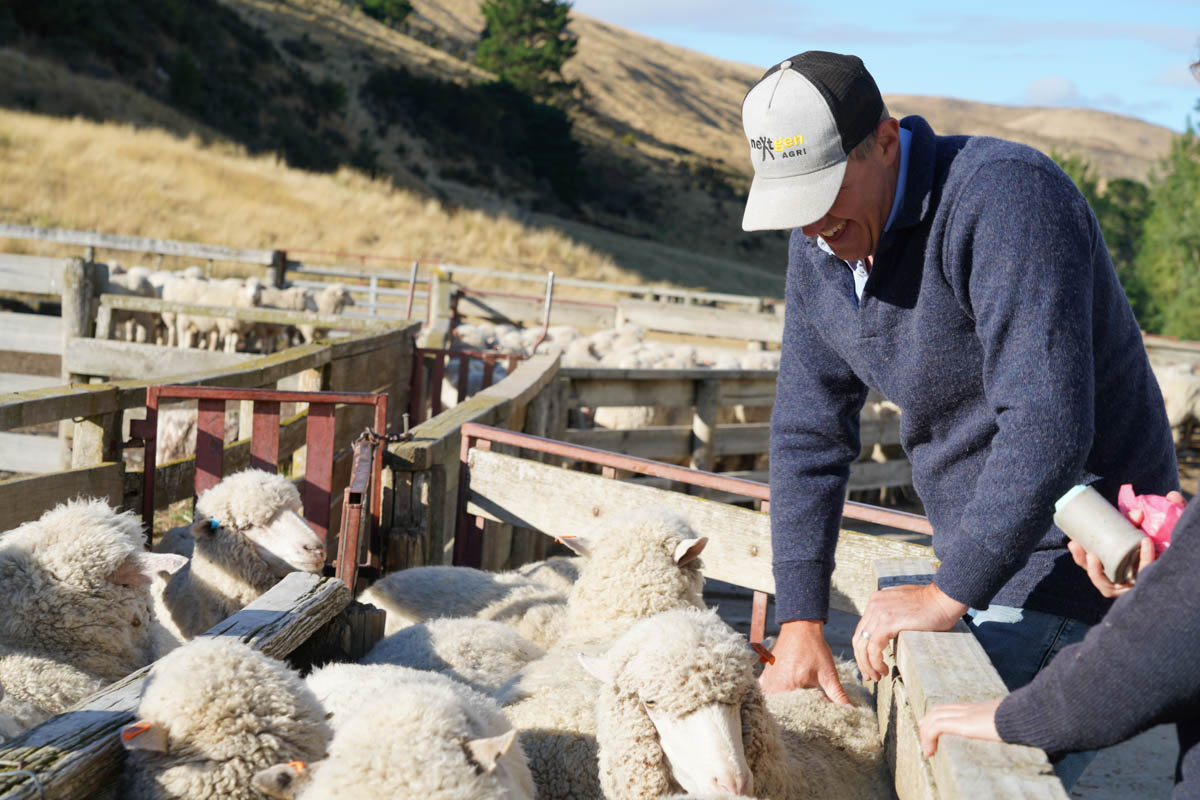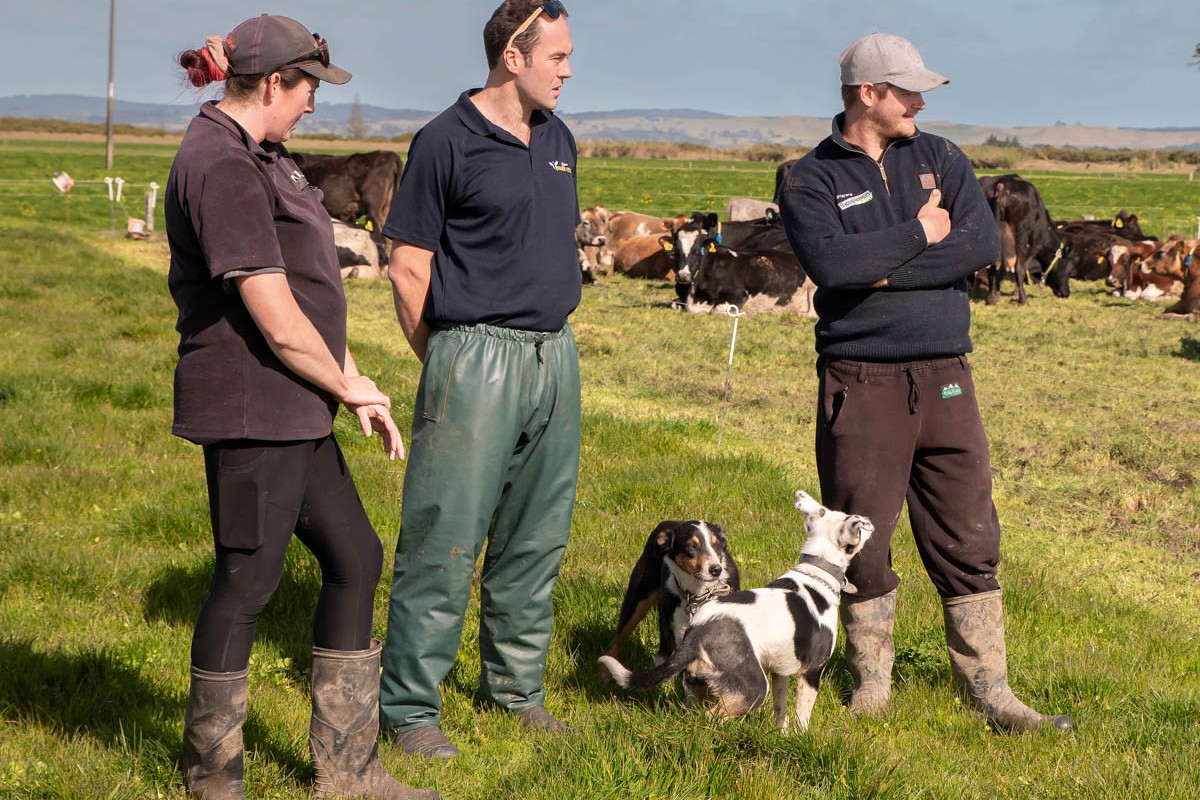On the home straight
Efficiency and consistency are the hallmarks of a Southland couple’s farming operation who are out to enjoy their last 10 years of farming. Terry Brosnahan reports.
Photos by Chris Sullivan.

Time is important to Bevan Hopcroft. He hates wasting it or even worse, people wasting his time. So Country-Wide deserved a rark up when we arrived half-an-hour late. Excuses of road works, a lost hearing aid and difficulty finding pudding for lunch didn’t cut any ice.
Thankfully Bevan doesn’t hold a grudge. It was also Bevan and his wife Wendy’s wedding anniversary so a bottle of bubbly instead of chocolate biscuits would have been more appropriate.
Bevan and Wendy run an efficient operation on their 397 hectare (379 effective) Wendonside farm in Southland. The couple married three weeks before they took over the farm.
It is a low-cost, high-output system they have built up during 27 years of marriage and farming the flat plateau farm.
The Hopcrofts’ farming operation appeared in Country-Wide after they won the New Zealand Ewe Hogget competition in 2015. They were then running 2400 Coopworth-Texel cross ewes, 640 hoggets and wintering for nine weeks, 300 dairy cows. The ewes scanned 200%, and lambed 165%.The hoggets scanned 115% and lambed 89%. In 2014 the lambs averaged 18kg carcaseweight (CW) and $99.
Gross farm income (GFI) at June 2015 was $1928/ha, farm working expenses (FWE) were $767/ha and the earnings before interest and tax (EBIT), 1161/ha.

Today they run 3200 Coopworth Texel ewes, 850 hoggets, graze 240 dairy cows for nine weeks in winter and have planted 16ha in pine trees.
In the 2021/2022 year, lamb prices were nearly $9/kg CW and the gross farm income was $2453/ha. The previous year it was $2034/ha, which included development costs of about $60,000 with the new farm.
In 2020/21 EBIT was $1278/ha and last year it was $1705/ha (excluding tree income and wages of management), with FWE 33% of GFI.
“They were two good years, but this year you can whack $700/ha off it,” Bevan says.
The lambs produced are still consistently meaty and fast growing with a 45% yield, though this year, due to the dry, are only yielding 42%.
The young pines are planted on escarpments. A block of 30-year-old trees was harvested two years ago which has helped reduce their undisclosed debt.
Wendy says they have concentrated on debt reduction in the past three years.
In 2020 they bought another 109ha adjoining the farm. The land is heavier and gives more scope. It hasn’t necessitated another labour unit.
Wendy is 50–75% of a labour unit as well as handling the administration side of the business.
“She is half the equation,” Bevan says.
Their motto used to be “the harder you work the luckier you get”. Now it is “let’s try to enjoy the moment”.
They’re both 53 and consider themselves to be in their last decade of farming, but they are still keen.
“We want to enjoy it without stressing about what’s ahead,” Bevan says.
They have been planning for it. Off-farm investments have been made into property and a crib in Riverton.
The investments have helped set up possible farm succession. Their two daughters Emma (24) and Charlotte (23) are working in Christchurch, while George (20) is in his final year at Lincoln University.
Back in 2011 they had an investment in a dairy farm but had little control. Bevan disagreed with the farming practices and they pulled out. They invested in a commercial property syndicate which gave 6-7% return on investment for the past five years.
They also run a small accommodation business on the farm and at their crib in Riverton. They enjoy meeting people so it’s a good fit.
A total of 24ha has been leased to a cropping farmer to grow barley. The Hopcrofts didn’t disclose the lease price, but say it is worth doing. The ground is leased out for 19 months to grow two crops. The lessee sows it back in permanent pasture and by April 1 the grass is six to eight weeks old.
An option might be to put in a winter feed crop instead of permanent pasture, so it’s a break crop for the grower. A key thing was to have rules on the soil fertility, which the Hopcrofts have built up over the 27 years.
Bevan would prefer the crop residue to be burned but the fire risk is too high.
The Olsen P levels are 30, potassium 7 and the pH is 6.1.
A lot of super went on when it was cheap and they may consider skipping next year. A whole-farm soil test is planned this year, last done 12 years ago as part of a potash trial.
The sudden drop in meat prices has been a bitter pill to swallow.
“Product prices went from hero to zero in six months,” Bevan says.
Changed meat company
The Hopcrofts were fed up with Alliance’s performance because it wasn’t treating everyone equally. Larger suppliers were getting special deals and better prices.
Bevan is a straight talker.
“We were loyal, supplying over 5000 head/year but were at the bottom of the heap.”
When the Hopcrofts held their ewe hogget winners’ field day back in 2015, Alliance chief executive David Surveyor praised the Hopcrofts for their excellence and consistent change, which took time. He said if Alliance was to achieve excellence it needed to run it the way the owners, farmer shareholders, wanted it run.
Bevan says they left Alliance two years ago and now supply South Pacific Meats which has same-day kill and no share capital required.
“They seem to be a few dollars ahead of the pack.”
Bevan says it is a shame co-operatives don’t stick to the principles they were founded on. If they did, they’d be in a better position now.
Inside the Hopcroft farm gate, flystrike is getting worse every year with warmer, muggy weather. It used to hit mid-January but now it is late December.
Wendy says input costs have rocketed with main expenses like fertiliser jumping from $60,000 to $100,000. They expect FWE to rise a considerable amount this year.
Buying another 109ha has given more heavier soils and helped feed to hang on longer in the dry. The increased scale has meant some loss of control over stock performance. Ewe lambing that peaked at 165% several years ago has fallen to 153%.
Hogget lambing is sitting at 80%.
This is the crucial part of the year because it determines whether the year will be a financial success or not. That’s why they intensively lamb, going around the sheep three times a day and saving lambs. Six lambing huts are scattered around the farm for minor problems.
The Hopcrofts have always tried to avoid hiring staff. When it was just 288ha, the weather was good and the place was humming, only Bevan and Wendy worked on it.
The increase in land and drier years has not yet meant another labour unit. Having children around as they grew up and even visits home have been a boost. This summer they had daughter Charlotte working five days a week for eight weeks. In future, the plan is to hire a young casual farm worker for jobs such as lamb crutching and topping, while Bevan and Wendy focus on stock.
Cattle are not farmed because of the climate.
“We steer clear of them,” Bevan says.
“You buy them when prices are on a high and sell them when dry on a low.”
Carrying out as much of the work themselves has been crucial to keeping farm working costs down especially when profit is low.
Bevan sheared his way into a farm and has kept farm costs down by shearing their sheep. Before they bought the extra land he was down to shearing half the flock, but it still made a huge saving.
“Our shearing bill has now gone nuts.”
From profit to negative
He shore when wool was $5/kg, but now at $1.50/kg it no longer excites him. However, even with paying for all the shearing they still managed to contain FWE to 40% of GFI. Last year there was a $20,000 profit from wool. After a further collapse in the wool prices, this will be the first time the return will be negative. They shear once a year, early January after weaning, don’t belly the sheep and do the dagging themselves.
Bevan says about every second year there is a new group invented to sort out wool and he wonders if they are going to run out of names for the new groups.
“You almost roll your eyes.”
He says farmers are hurting this year so change is needed very soon.
He doesn’t begrudge the shearers being paid for hard work.
“They deserve everything they get.”
He pays $6/sheep for shearing and is getting $3 for the wool. “It doesn’t entice you to invest in a new shearing shed.”
Wendy says shearing is a management tool.
Any ewe that only lambs a single goes into the B mob and goes to a Poll Dorset or a Texel Suffolk.
Bevan selects twin lambs from twin-reared ewes and expects the flock fertility to go up a little each year, but it seems to have plateaued.
In 2016 the ewes scanned 200%. For five years they were in the high 180s. Last year they scanned 174%.
“It is due to the drier climate and being off the pace.”
The rising four-tooths have been lambed as hoggets and two-tooths, but kept separate from the main mob until scanning because they are younger sheep.
“They are still growing and are in better condition when not competing with the mixed-age ewes.” Bevan says 800–900 is the right size mob for the farm.
For the first time this year they have planted kale. Bevan is in a hogget lambing group, set up under the Red Meat Profit Partnership.
The group carried on after the programme finished and after one meeting Bevan decided to grow a paddock. A farmer in the group was feeding his sheep nearly all kale for winter feed and the sheep did well. Bevan had 100 lambs grazing on 5ha of Bonavere kale, eating the tops and grass around the edge of the paddock. In winter it will feed the two-tooths.
There is also 17ha of Major Plus swedes.
The Hopcrofts still don’t have a lot of machinery – plant is valued in the accounts at $70,000. They are still actively involved in the community. In fact Bevan was toey about us being late because he was delayed in helping out the community’s big project, restoring the local 111-year-old hall (see p8). They regard being involved in their community is good for mental health.
“It is also good for your business”, Bevan says.
A bonus is making contacts at the sideline of sport or at community events.
“You live in a community, you play in a community.”
Part of Bevan and Wendy’s final 10-year plan is to reduce the sheep workload by changing stock numbers to 2500 ewes, 750 hoggets, 300 dairy cows and lease 80ha of grain.
That’s dependent on the dairy farmer still grazing cows and the arable farmer wanting to grow grain.
“It is good land so it’s lucky we have options,” Wendy says.
The dry weather forced them to sell the bottom 430 lambs. Rain came a day after they were sold but was only 5mm.
“That lasted half a day,” Bevan says.
Bevan and Wendy’s key message is to keep positive, always look for learning and business opportunities and try to enjoy the moment. They intend to do this for the next 10 years.




